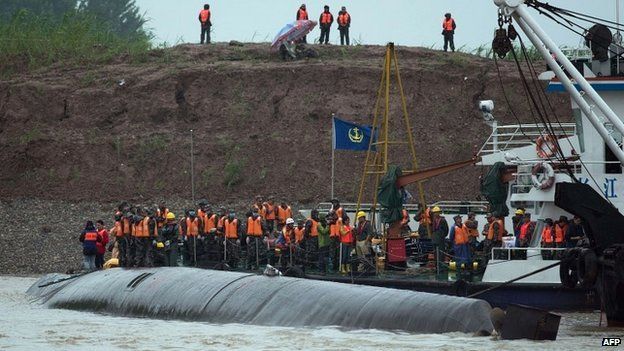Why did Chinese cruise ship capsize on the Yangtze?
- Published

More than 350 people remain unaccounted for after a cruise ship capsized on China's Yangtze River on Monday, and it is still unclear what caused the tragedy.
The boat was carrying 405 passengers - mostly elderly tourists - as well as five travel agency employees and 46 crew members.
With Chinese officials keeping journalists at a safe distance, brief accounts from some of the 14 people rescued offer the best clues as to what caused the Eastern Star to overturn.
We know that whatever happened, it happened quickly. One survivor said the ship capsized "incredibly fast" while another said it happened "within a minute".
Freak storm?
The captain Zhang Shunwen, and chief engineer Yang Zhongquan were among the survivors.
Both reportedly said the vessel was caught in a freak storm and one passenger described it as tilting at a "45-degree angle" before going down.
This was backed up by meteorologists in China who confirmed that a "sudden, strong and violent" storm hit the area at the time of the incident.
A video taken from a nearby ship showed the Eastern Star travelling amid fierce rain and lightning.
The suddenness of the storm could explain why no emergency signal was sent.
But, like details about the ship's speed and course, this is likely to remain an unknown until police have finished questioning the captain.
Officials have insisted that the ship was not overcrowded and had enough lifejackets and lifeboats, but say there simply wasn't enough time for the crew or passengers to react.
Local media have since pointed out that there were multiple weather warnings issued by regional authorities in Hubei and Jingzhou earlier on 1 June, including one warning against "dangerous sailing".
It is not clear whether the captain had received them, or if he did, whether he had simply ignored them.
Questions have been raised of Mr Zhang's competency. But employees of his company, Eastern Shipping, said the captain, who is in his 50s, was "technically skilled" and "reliable" in a report by Beijing Youth Daily.
The Eastern Star
- The 76m-long, 2,200 tonne ship was named Dongfangzhixing in Chinese
- It was carrying 405 passengers - mostly elderly tourists but one three-year-old - as well as five travel agency employees and 46 crew members.
- The ship is owned by the Chongqing Eastern Shipping Corporation, and passengers had booked their trip through a travel agency in Shanghai.
- The cruise left the eastern city of Nanjing in April and was travelling to Chongqing in the south-west via the Three Gorges - a journey of at least 1,500km (930 miles).
If bad weather was to blame, it remains unclear why the ship was the only one to capsize on the busy river.
The captain of a freighter Tonggonghua 666 that passed the Eastern Star shortly before it overturned said he experienced fog-like conditions and that the rain interfered with his radar.
He eventually anchored his ship on shore while the storm passed. So did the captain of another nearby ship, Changhang Jiangning.
One theory is that Eastern Star may have toppled as it attempted to drop anchor.
In an interview with Shanghai Morning Post, Changhang Jiangning's captain said Eastern Star's crew radioed him around 9.20pm - 10 minutes before it allegedly capsized - saying: "We are planning to anchor behind you."
The captain said he then had to focus on anchoring his own ship, which required turning the vessel to face the wind to maintain stability.
When the procedure was completed, Eastern Star had vanished and was uncontactable, he said.
A map showing Eastern Star's path in those final minutes published in local media shows the boat made a sharp right turn around 9.20pm and appeared to be heading towards the far shore.
Defects on board?
The 76m-long, 2,200 tonne ship is owned by the Chongqing Eastern Shipping Corporation. According to state media, it was built in 1994 and was designed to carry 534 people.
Authorities in Nanjing, where the Eastern Star began its final journey, are reported to have held the ship and five other cruiseliners for violating standards during a safety inspection campaign in 2013.
Records on the Nanjing Maritime Safety website show the vessel was detained but the reasons why are unclear. Chinese news website Caixin reported that it has had frequent modifications in recent years.
Some experts suggest that a river cruiser of its type would not have been able to withstand reported winds of up to 80mph (130 kph).
"The river ships tend to have a lower standard on wind-resistance and wave-resistance than ocean ships," Zhong Shoudao, president of the Chongqing Boat Design Institute, told reporters.
With Chinese authorities remaining tight-lipped, it could be some time before we know for sure what caused this tragedy.